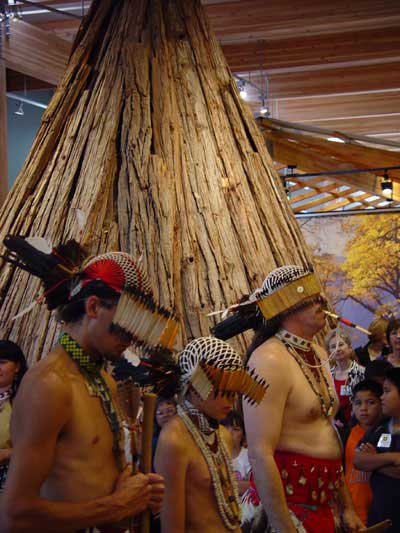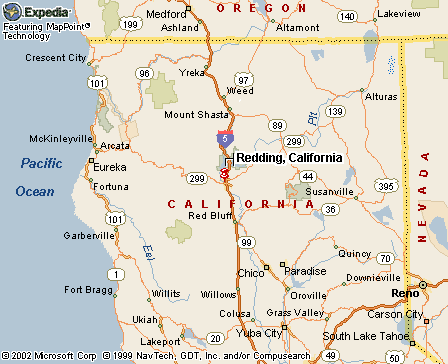|
|
Canku Ota |
|
|
(Many Paths) |
||
|
An Online Newsletter Celebrating Native America |
||
|
June 29, 2002 - Issue 64 |
||
|
|
||
|
'Journey to Justice' Tells Poignant Tale of Almost-forgotten California Tribe |
||
|
by Janet Fullwood -- Sacramento
Bee Travel Editor
|
||
|
credits: Wintu dancers
with Wintu Bark House in background, Turtle
Bay Museum, 6/7/02
|
 REDDING,
CA - For 127 years, a collection of lovingly crafted pine-nut skirts,
feather headdresses, animal-skin quivers and exquisitely woven baskets
sat in storage at the Smithsonian Institution's Museum of Natural History
in Washington, D.C. REDDING,
CA - For 127 years, a collection of lovingly crafted pine-nut skirts,
feather headdresses, animal-skin quivers and exquisitely woven baskets
sat in storage at the Smithsonian Institution's Museum of Natural History
in Washington, D.C.
Made by the Wintu people of the McCloud River region, the artifacts had been obtained by a man sent to Northern California on an improbable U.S. government mission: to harvest the eggs of Pacific salmon and plant them in the depleted rivers of the East. The salmon-breeding project didn't work. But this month, the 64 objects collected in the early 1870s by Livingstone Stone saw light for the first time since Ulysses S. Grant was president. For the Wintu descendants of the objects' makers, the repatriation is bittersweet. "After all these years, the things that belong to the Wintu have finally come back to Wintu territory. We had a very emotional ceremony to welcome them back," said Gene Malone, 39, a Wintu leader deeply involved in his people's ongoing quest for recognition. The cherished artifacts are on display through October 2003 in "Journey to Justice," the keystone exhibit at the new $15 million Turtle Bay Museum in Redding. They help tell the story of an almost-forgotten people who for centuries lived along the shores of the McCloud River. Now controlled by dams, the McCloud once ran cold and swift, teeming with salmon, from the foot of Mount Shasta to the Sacramento River near what is now Redding. The McCloud Wintu were one of nine northern Wintu bands and part of a larger, Wintu-speaking culture that inhabited the Sacramento River watershed from Mount Shasta to San Francisco Bay. Their culture thrived until trappers out of Fort Vancouver, Ore., showed up in the early 1800s. "Pre-contact, they numbered about 34,000 people and comprised the greatest concentration of Indian population in all North America," says Alice Hoveman, who curated the exhibit and wrote a book about the Wintu story. Displays in "Journey to Justice" show how a century of Western contact decimated the tribe through environmental degradation, starvation, murder, political deceit and disease. Exhibits tell about unratified treaties, broken agreements and government policies that first sought to exterminate the Wintu and other tribes and then, when that didn't work, to crush their tribal identities and terminate their bonds to the land. By 1900, the Wintu nation had been reduced to about 400 souls. The final blow to their identity came with the building of Shasta Dam in the 1930s. Shasta Lake flooded traditional Wintu lands, inundated sacred sites and all but exterminated the winter salmon run on which they once had depended. Remaining Wintu were left holding onto their traditions by a thread, without land, rights or governmental recognition to prop up what remained of their once-proud culture. Today more than 2,000 people claim Wintu blood, and they are fighting to claim a place alongside the 559 tribes recognized and accorded certain rights by the U.S. Department of the Interior. Recognition would serve primarily to validate the group's heritage, said Frank LaPena, a Wintu scholar and artist who recently retired after 25 years as director of the native studies program at California State University, Sacramento. "One of the most important things about recognition is legitimizing the elders' stories and talk of culture for the young," he says. "Recognition legitimizes you in one sense. But you have to overcome a lot of inertia -- and there's a lot of historic amnesia at work here. "Non-recognition treats the destruction of culture as a legitimate process." LaPena and his son Vince, an interpreter at Effie Yeaw Nature Center in Sacramento who teaches elementary school students and their teachers about Indian ways, were among many Wintu on hand for opening ceremonies at the museum. Observances included solemn prayer ceremonies and lively traditional dances. Hoveman, the exhibit curator, maintains that while the focus of "Journey to Justice" is on the Wintu, its reach is far broader than that. "It's a very common story for all native peoples in North America," she said. "We're trying to produce a context for the situation the Wintu and many other native tribes face today." Groundwork on "Journey to Justice" began about a decade ago. Wintu leaders were heavily involved from the start with Hoveman and the anthropologist, archaeologist, biologist and others working on the project. But they didn't immediately cotton to the idea of taking public the tragic story of their genocide. "When we first started talking in 1992 about the exhibit, we were a little apprehensive," Malone says. "It took a lot of talk among the tribal people to decide that yes, we want to do this. We want this story told." The exhibit should be a significant help in the tribe's quest for legitimacy, he believes. "We want to encourage everybody to look at this display and say, 'They were a tribe back then, why aren't they a tribe today?' This is going to educate people on what really happened." Throughout the exhibit, which tells a chronological story, the plight of the Wintu is integrated with that of the salmon on which they subsisted. "Prior to the building of Shasta Dam, the history of the people and the history of the salmon were very tied together," Hoveman says. "After Shasta Dam, they're two separate histories." The impact of Shasta Dam on the salmon run in the McCloud, Trinity, Sacramento and other area rivers has been the subject of much science over the years. Exhibits explain how hundreds of millions of federal dollars have been spent in a partially successful attempt to restore the fish population. The Wintu have not been on the receiving end financially. But they take pride in the new educational tool at Turtle Bay and hope the public will learn from and harken to their cause. "My grandmother has been waiting 92 years to officially be called a Wintu," says Malone, laying an affectionate hand on the shoulder of Lala Curl, who attended the museum's opening ceremonies in a wheelchair, wearing a traditional Wintu basket cap. "I believe this facility will help educate and preserve the Wintu people." The last display visitors see when touring "Journey to Justice" is a poem by LaPena, who signs it with his Indian name, Towendolly. "There are secret places, known by dreams. Sometimes we find them, or they find us," it starts out. With "Journey to Justice," the Wintu story is secret no more.
|
||||||||
|
|
||
|
|
||
| Canku Ota is a free Newsletter celebrating Native America, its traditions and accomplishments . We do not provide subscriber or visitor names to anyone. Some articles presented in Canku Ota may contain copyright material. We have received appropriate permissions for republishing any articles. Material appearing here is distributed without profit or monetary gain to those who have expressed an interest. This is in accordance with Title 17 U.S.C. section 107. | ||
|
Canku Ota is a copyright © 2000, 2001, 2002 of Vicki Lockard and Paul Barry. |
||
 |
 |
|
|
The "Canku Ota - A Newsletter Celebrating Native America" web site and its design is the |
||
|
Copyright © 1999, 2000, 2001, 2002 of Paul C. Barry. |
||
|
All Rights Reserved. |
||
